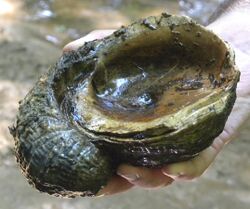Biology:Exogyra
| Exogyra | |
|---|---|

| |
| Exogyra flabellata (Owl Creek Formation, Late Cretaceous, Mississippi) | |
| Scientific classification | |
| Domain: | Eukaryota |
| Kingdom: | Animalia |
| Phylum: | Mollusca |
| Class: | Bivalvia |
| Order: | Ostreida |
| Family: | Gryphaeidae |
| Genus: | †Exogyra Say, 1820 |
| Species | |
|
See text | |
Exogyra is an extinct genus of fossil marine oysters in the family Gryphaeidae, the foam oysters or honeycomb oysters.[1] These bivalves were cemented by the more cupped left valve. The right valve is flatter, and the beak is curved to one side. Exogyra lived on solid substrates in warm seas[citation needed] during the Jurassic and Cretaceous periods.[2]
Taxonomy
The former subgenus Exogyra (Aetostreon) Bayle, 1878,[3] is sometimes considered a separate genus due to a lack of the fine set of parallel ribs (chomata) separated by pits on the inner surface of the valves (which is present in the nominate subgenus).[4]
Species

Distribution
Fossils of Exogyra have been found in:[2]
- Jurassic
Afghanistan, Chile, China, Eritrea, Ethiopia, France, Germany, India, Kenya, Poland, Portugal, Somalia, Spain, Tanzania, the United Kingdom, and Yemen.
- Cretaceous
Afghanistan, Algeria, Argentina, Brazil, Bolivia, Canada (British Columbia), Bulgaria, Chile, Colombia (Hiló Formation, Tolima, Macanal and Chipaque Formations, Eastern Ranges),[12][13] Cuba, the Czech Republic, Egypt, Ethiopia, France, Germany, Greenland, Hungary, India, Iran, Italy, Jordan, Lebanon, Libya, Madagascar, Mexico, Morocco, Mozambique, New Zealand, Nigeria, Oman, Pakistan, Peru, Poland, Portugal, Serbia and Montenegro, Slovakia, South Africa, Spain, Sweden, Switzerland, Tanzania, Trinidad and Tobago, Tunisia, Turkey, USSR, Ukraine, the United Kingdom, United States (Alabama, Arizona, Arkansas, California, Colorado, Delaware, Georgia, Maryland, Minnesota, Mississippi, Missouri, Montana, New Jersey, New Mexico, North Carolina, Oklahoma, South Carolina, Tennessee, Texas, Utah, Wyoming), Venezuela, and Yemen.
References
- ↑ "Evolution of Exogyra plexa". http://crnmac1.physics.uiowa.edu/fossils/oysters/ilymatogyra/Exogyra-plexa.html.
- ↑ 2.0 2.1 Exogyra at Fossilworks.org
- ↑ "†Exogyra (Aetostreon) Bayle 1878". Paleobiology Database. Fossilworks. http://www.fossilworks.org/cgi-bin/bridge.pl?a=taxonInfo&taxon_no=118251.
- ↑ Pugaczewska, Halina (1975). "Neocomian oysters from Central Poland". Acta Palaeontologica Polonica 20 (1): 47–72. http://www.app.pan.pl/archive/published/app20/app20-047.pdf.
- ↑ Exogyra africana
- ↑ Exogyra davidsoni at Fossilworks.org
- ↑ Exogyra
- ↑ Lake.P., and Rastall.R.H., (1913), A Text Book of Geology, 2nd edition, London: Edward Arnold's Geological series Page 426 and 436
- ↑ Exogyra praevirgula
- ↑ Global Names Index
- ↑ Ivanov. M., Hrdlickova. S., and Gregorova. R., (2005), The Complete Encyclopedia of Fossils, 3rd. ed., Lisse: Rebo International, page 133
- ↑ Piraquive et al., 2011, p. 204
- ↑ Acosta & Ulloa, 2002, p. 54
Bibliography
- Acosta, Jorge E., and Carlos E. Ulloa. 2002. Mapa geológico del Departamento de Cundinamarca 1:250,000 - Memoria Explicativa, 1–108. Colombian Geological Survey.
- Piraquive, Alejandro; Juan Sebastián Díaz; Tomas Cuéllar; Germán Pardo, and Andreas Kammer. 2011. Reactivación Neógena de estructuras de rift del Cretácico Temprano asociadas con la Falla de Chámeza, Pajarito, Boyacá (Colombia): evidencias tectónicas y bioestratigráficas. Geología Colombiana 36. 197–216.
Further reading
- National Audubon Society Field Guide to North American Fossils
Wikidata ☰ Q127941 entry
 |

